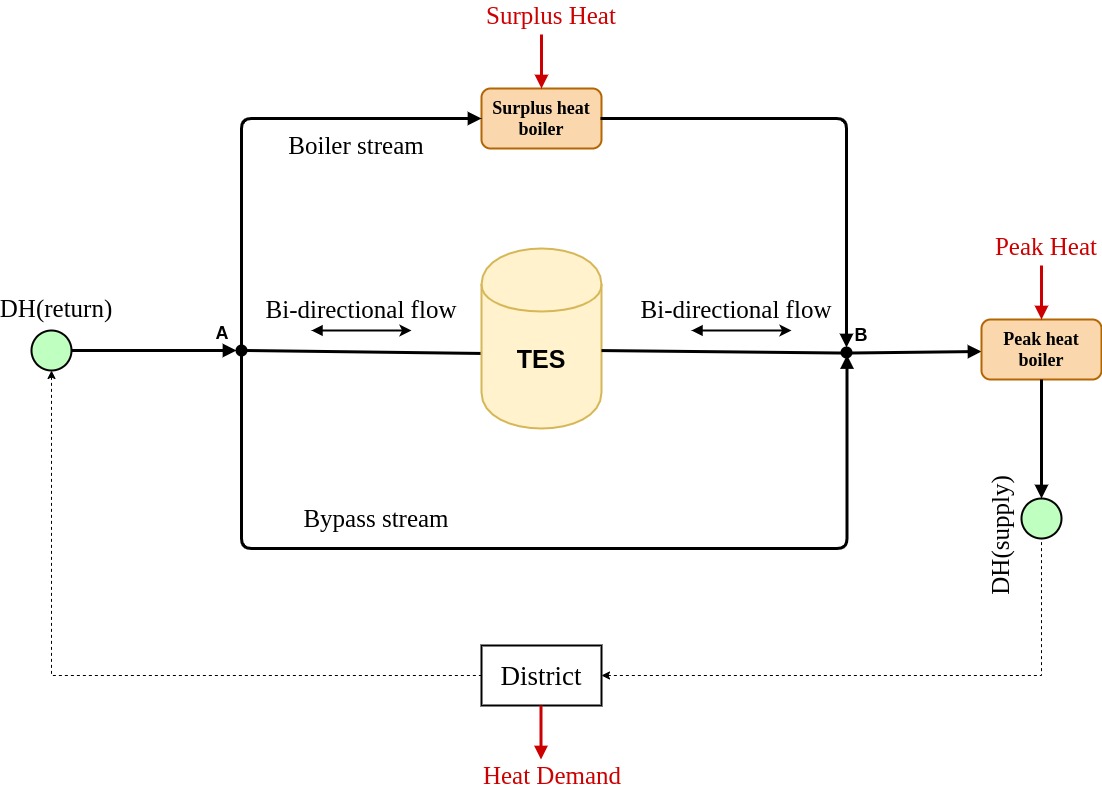(541e) An Mpcc Approach to Robust Optimal Sizing of Thermal Energy Storage with Bidirectional Flows
AIChE Annual Meeting
2020
2020 Virtual AIChE Annual Meeting
Computing and Systems Technology Division
Industrial Applications in Design and Operations
Wednesday, November 18, 2020 - 9:00am to 9:15am
The basic topology of the district heating network, based on a district heating company in northern Norway, is shown in the uploaded figure. The surplus industrial heat is supplied through a surplus heat boiler (SHB). When the available heat is insufficient to satisfy district heating demand, the fossil-based peak heating is supplied through the peak heat boiler (PHB) to heat up the stream to the required temperature. The cold stream returned from the district splits at node A into 3 streams, going to the SHB, the TES, or bypassing directly to the PHB. The flow through the TES is bidirectional, depending on whether the TES is charging or discharging. When the heat supply is greater than the demand, the heat from the outlet of SHB is used to charge the TES (flow from node B to node A). On the other hand, when there is excess demand, the TES discharges the stored heat into the supply stream (flow from node A to node B).
The design objective is to minimize the capital costs associated with the size of the TES unit, and the operation objective is to minimize the use of peak-heating sources. We use a stochastic programming approach where the objective of the optimization problem includes the capital costs and a weighted sum of the operating costs of all scenarios (where each scenario is a combination of a representative heat supply and heat demand profile). The bidirectional flow through the TES is modeled with complementarity constraints, rendering the optimization problem a mathematical program with complementarity constraints (MPCC). The MPCC can be solved by relaxing the complementarity constraints with a square-root approximation parametrized by some ε. The idea is to first solve the problem with a relatively large ε, and to promote convergence by iteratively decrease its value by initializing the solver (Ipopt) with the solution of the previous iteration [1,2]. The process can be sped up by solving the problem for a large ε*, and then taking a parametric NLP-sensitivity step (w.r.t. ε) from ε = ε* to ε = 0 [3]. The solution obtained gives the optimal sizing of the TES unit that is robust against fluctuations in heat supply and demand profiles.
References:
[1] Daniel Ralph & Stephen J. Wright (2004) Some properties of regularization and penalization schemes for MPECs, Optimization Methods and Software, 19:5, 527-556, DOI: 10.1080/10556780410001709439
[2] Leyffer S. (2006) Complementarity constraints as nonlinear equations: Theory and numerical experience. In: Dempe S., Kalashnikov V. (eds) Optimization with Multivalued Mappings. Springer Optimization and Its Applications, vol 2. Springer, Boston, MA
[3] Pirnay, H., López-Negrete, R. & Biegler, L.T. Optimal sensitivity based on IPOPT. Math. Prog. Comp 4, 307–331 (2012). https://doi.org/10.1007/s12532-012-0043-2
